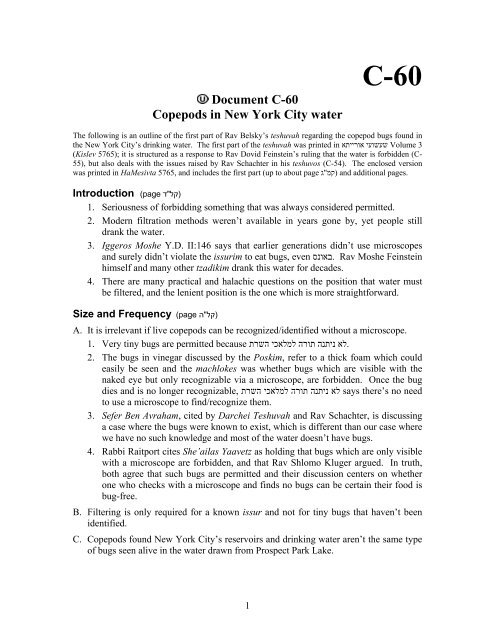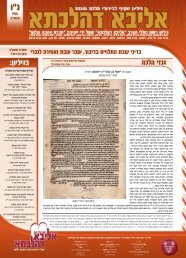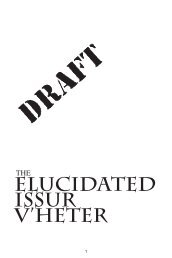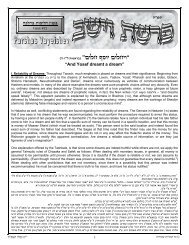C-60_Copepods_in_NYC_water-Rav_Belsky_ ... - Ner Gavriel
C-60_Copepods_in_NYC_water-Rav_Belsky_ ... - Ner Gavriel
C-60_Copepods_in_NYC_water-Rav_Belsky_ ... - Ner Gavriel
You also want an ePaper? Increase the reach of your titles
YUMPU automatically turns print PDFs into web optimized ePapers that Google loves.
Document C-<strong>60</strong><br />
<strong>Copepods</strong> <strong>in</strong> New York City <strong>water</strong><br />
C-<strong>60</strong><br />
The follow<strong>in</strong>g is an outl<strong>in</strong>e of the first part of <strong>Rav</strong> <strong>Belsky</strong>’s teshuvah regard<strong>in</strong>g the copepod bugs found <strong>in</strong><br />
the New York City’s dr<strong>in</strong>k<strong>in</strong>g <strong>water</strong>. The first part of the teshuvah was pr<strong>in</strong>ted <strong>in</strong> תא Volume 3<br />
(Kislev 5765); it is structured as a response to <strong>Rav</strong> Dovid Fe<strong>in</strong>ste<strong>in</strong>’s rul<strong>in</strong>g that the <strong>water</strong> is forbidden (C-<br />
55), but also deals with the issues raised by <strong>Rav</strong> Schachter <strong>in</strong> his teshuvos (C-54). The enclosed version<br />
was pr<strong>in</strong>ted <strong>in</strong> HaMesivta 5765, and <strong>in</strong>cludes the first part (up to about page "ג (קמ and additional pages.<br />
שעשועי אוריי<br />
Introduction (page<br />
1. Seriousness of forbidd<strong>in</strong>g someth<strong>in</strong>g that was always considered permitted.<br />
2. Modern filtration methods weren’t available <strong>in</strong> years gone by, yet people still<br />
drank the <strong>water</strong>.<br />
3. Iggeros Moshe Y.D. II:146 says that earlier generations didn’t use microscopes<br />
and surely didn’t violate the issurim to eat bugs, even .באונס <strong>Rav</strong> Moshe Fe<strong>in</strong>ste<strong>in</strong><br />
himself and many other tzadikim drank this <strong>water</strong> for decades.<br />
4. There are many practical and halachic questions on the position that <strong>water</strong> must<br />
be filtered, and the lenient position is the one which is more straightforward.<br />
(קל "ד<br />
(קל "ה Size and Frequency (page<br />
A. It is irrelevant if live copepods can be recognized/identified without a microscope.<br />
.לא ניתנה תורה למלאכי השרת 1. Very t<strong>in</strong>y bugs are permitted because<br />
2. The bugs <strong>in</strong> v<strong>in</strong>egar discussed by the Poskim, refer to a thick foam which could<br />
easily be seen and the machlokes was whether bugs which are visible with the<br />
naked eye but only recognizable via a microscope, are forbidden. Once the bug<br />
dies and is no longer recognizable, לא ניתנה תורה למלאכי השרת says there’s no need<br />
to use a microscope to f<strong>in</strong>d/recognize them.<br />
3. Sefer Ben Avraham, cited by Darchei Teshuvah and <strong>Rav</strong> Schachter, is discuss<strong>in</strong>g<br />
a case where the bugs were known to exist, which is different than our case where<br />
we have no such knowledge and most of the <strong>water</strong> doesn’t have bugs.<br />
4. Rabbi Raitport cites She’ailas Yaavetz as hold<strong>in</strong>g that bugs which are only visible<br />
with a microscope are forbidden, and that <strong>Rav</strong> Shlomo Kluger argued. In truth,<br />
both agree that such bugs are permitted and their discussion centers on whether<br />
one who checks with a microscope and f<strong>in</strong>ds no bugs can be certa<strong>in</strong> their food is<br />
bug-free.<br />
B. Filter<strong>in</strong>g is only required for a known issur and not for t<strong>in</strong>y bugs that haven’t been<br />
identified.<br />
C. <strong>Copepods</strong> found New York City’s reservoirs and dr<strong>in</strong>k<strong>in</strong>g <strong>water</strong> aren’t the same type<br />
of bugs seen alive <strong>in</strong> the <strong>water</strong> drawn from Prospect Park Lake.<br />
1
.מיעוט המצוי & frequency D. Visibility & size;<br />
1. How the presence of bugs <strong>in</strong> New York City’s <strong>water</strong> was discovered.<br />
2. <strong>Copepods</strong> can’t be considered visible to the naked eye if no one dr<strong>in</strong>k<strong>in</strong>g the<br />
<strong>water</strong> saw a bug dur<strong>in</strong>g the past 100 years.<br />
3. Even “experts” often have trouble f<strong>in</strong>d<strong>in</strong>g visible, “real” bugs <strong>in</strong> the <strong>water</strong>.<br />
4. Some people can see copepods without magnification, but most people can’t<br />
unless many bugs are collected <strong>in</strong> a small vial.<br />
(קל "ט Status of Reservoirs (page<br />
E. Reservoirs are considered בורות and therefore bugs found <strong>in</strong> them are permitted until<br />
they leave the <strong>water</strong>.<br />
1. Description of New York City’s <strong>water</strong> delivery and reservoir system<br />
2. The copepods grow <strong>in</strong> Kensico reservoir and are killed by chlor<strong>in</strong>e and<br />
turbulence.<br />
3. Def<strong>in</strong>ition of ”בור“ and ”נובעים“ as relates to hilchos tola’im (i.e. the current status<br />
of the <strong>water</strong>) is different than for hilchos Mikvaos (i.e. the source of the <strong>water</strong>).<br />
4. Accord<strong>in</strong>g to the understand<strong>in</strong>g of those who forbid the <strong>water</strong>, a ”בור“ as relates to<br />
hilchos tola’im doesn’t exist.<br />
5. Kensico reservoir is a בור like any other and the source of its <strong>water</strong> is irrelevant.<br />
6. Ra’avad holds that a ביבר <strong>in</strong> which the <strong>water</strong> is only removed from the side (as<br />
.בור opposed to the top) isn’t considered a<br />
7. The term ”ביברין“ is limited to bodies of <strong>water</strong> that are connected to a river.<br />
8. A ביבר is a body of <strong>water</strong> which hasn’t reached its “f<strong>in</strong>al dest<strong>in</strong>ation” (before use)<br />
while a בור refers to <strong>water</strong> collected for its f<strong>in</strong>al use.<br />
9. Kensico reservoir is a בור s<strong>in</strong>ce the collected <strong>water</strong> is now ready for end-use and<br />
won’t return to the flow of a river.<br />
F. What’s to be lost by filter<strong>in</strong>g<br />
10. Filter<strong>in</strong>g <strong>water</strong> makes it halachically worse because when the filter dis<strong>in</strong>tegrates<br />
the trapped bugs will get <strong>in</strong>to the dr<strong>in</strong>k<strong>in</strong>g <strong>water</strong> (and such bugs are forbidden<br />
.(בור s<strong>in</strong>ce they’ve already left the<br />
11. <strong>Copepods</strong> are so small and out <strong>water</strong> is pressurized, that the bugs pass through the<br />
cloth.<br />
12. EZFilter doesn’t have aforementioned concerns, but…<br />
(קמ "ג Shabbos (page<br />
G. Filter<strong>in</strong>g on Shabbos<br />
1. Water that can’t be drunk without filter<strong>in</strong>g, can’t be filtered on Shabbos. Some<br />
suggest, based on Nishmas Adam (even though Chayei Adam disagrees), that<br />
separat<strong>in</strong>g issur from heter is permitted if the issur isn’t <strong>in</strong>herently undesirable.<br />
2. Magen Avraham 500:12 says chailev <strong>in</strong> meat is one m<strong>in</strong> so it isn’t borer to traiber<br />
the meat because they are only “2 m<strong>in</strong>im” as a result of the issur to eat chailev. In<br />
2
other words, issur can’t make one m<strong>in</strong> <strong>in</strong>to 2. However, if 2 m<strong>in</strong>im are mixed, it’s<br />
borer even if the only reason you’re remov<strong>in</strong>g one m<strong>in</strong> (the copepod) is due to its<br />
issur.<br />
3. If copepods cause the <strong>water</strong> to be assur, it’s clearly borer to filter the <strong>water</strong>.<br />
4. Chazon Ish only permitted “borer” if the filter was just to keep leaves out (as<br />
opposed to filter<strong>in</strong>g for dirt). Chazon Ish does not differentiate between a filter<br />
that is attached or separate from the s<strong>in</strong>k.<br />
5. Hav<strong>in</strong>g <strong>in</strong> m<strong>in</strong>d that you’re runn<strong>in</strong>g the <strong>water</strong> for hand-wash<strong>in</strong>g (and then us<strong>in</strong>g<br />
some for dr<strong>in</strong>k<strong>in</strong>g) doesn’t make you an a<strong>in</strong>o miskaven for the borer.<br />
6. Most Jews follow the op<strong>in</strong>ion that New York City <strong>water</strong> doesn’t need filter<strong>in</strong>g, so<br />
the <strong>water</strong> should be considered “dr<strong>in</strong>kable without filter<strong>in</strong>g” and filter<strong>in</strong>g should<br />
be permitted on Shabbos…<br />
7. …But those who hold filter<strong>in</strong>g is required, hold that everyone requires it, so<br />
accord<strong>in</strong>g to them the <strong>water</strong> is not dr<strong>in</strong>kable for most people. Water that’s for<br />
wash<strong>in</strong>g dishes and vegetables can be filtered s<strong>in</strong>ce not “needed”.<br />
8. Those who hold the <strong>water</strong> doesn’t require filter<strong>in</strong>g and are do<strong>in</strong>g so just as a<br />
chumrah, are allowed to filter dr<strong>in</strong>k<strong>in</strong>g <strong>water</strong> on Shabbos.<br />
H. Clean<strong>in</strong>g EZFilter on Shabbos<br />
1. EZFilter has to be cleaned every day or two which raises the issue of boneh/soser<br />
if one unscrews it on a 2-3 day Yom Tov and puts it back on.<br />
2. As relates to b<strong>in</strong>yan for keilim, someth<strong>in</strong>g which is usually rafui/loose is<br />
permitted. But as relates to b<strong>in</strong>yan <strong>in</strong> the ground (i.e. where even rafui is<br />
effective) even a loose attachment is assur.<br />
3. Screw<strong>in</strong>g on an EZFilter makes it fully functional so it is b<strong>in</strong>yan even though it’s<br />
rafui.<br />
4. Attach<strong>in</strong>g an EZFilter isn’t considered a b<strong>in</strong>yan arai (temporary build<strong>in</strong>g). The<br />
EZFilter is considered kavuah even though it has to be taken off every day or two.<br />
Hilchos Ta’aruvos vs. chiyuv bedikah (page<br />
1. People confuse the halachos of ta’aruvos with those of bedikah for a miut<br />
hamatsui. When should you use rules of lach b’lach, beryah, and davar chashuv,<br />
and when should you follow rov.<br />
2. Recent confusion forces him to expla<strong>in</strong> the difference.<br />
3. Hilchos ta’aruvos applies when issur (or its ta’am) is hopelessly lost <strong>in</strong> a food <strong>in</strong><br />
a manner that is not discernable or removable.<br />
4. Hilchos ta’aruvos applies when we know that someth<strong>in</strong>g from a group of issur (or<br />
safek issur) fell <strong>in</strong>to the group of heter. But if there never was issur by itself<br />
(which fell <strong>in</strong>) then it’s not a ta’aruvos even though we are 100% sure that some<br />
(קמ "ח<br />
3
issur (e.g. teraifos) is <strong>in</strong>herent to the group. [In that sense, a ta’aruvos requires a<br />
sure issur (or safek issur) to be <strong>in</strong> the mixture].<br />
5. When one of the ta’aruvos leaves the group, we can (sometimes) be toleh/assume<br />
that it was the issur that left. This is because once one leaves, you can no longer<br />
be sure that there is issur <strong>in</strong> the group (because it may be that the issur left), so it<br />
loses its identity as a “ta’aruvos”.<br />
6. A ta’aruvos must be limited to a def<strong>in</strong>ed group and can’t be all the animals or all<br />
the cabbage <strong>in</strong> the entire world or area.<br />
7. Water system <strong>in</strong> New York City can’t be viewed as a ta’aruvos of issur (bugs)<br />
and heter (<strong>water</strong>) because (a) no issur was ever seen to fall <strong>in</strong>to the heter and (b)<br />
the system is too large and undef<strong>in</strong>ed to be a “group”.<br />
Miut Hamatsui (page<br />
1. Mid’rabannan, one is required to check for th<strong>in</strong>gs that are miut hamatsui even<br />
though mid’oraisah you’d rely on rov.<br />
2. Check<strong>in</strong>g <strong>in</strong> cases of miut hamatsui is a takanah (<strong>in</strong> many cases) rather than a d<strong>in</strong>.<br />
3. Def<strong>in</strong>ition of miut hamatsui; Rivash – close to rov, happens commonly, can’t<br />
escape it, not surprised to f<strong>in</strong>d it…<br />
4. Mishkenos Yaakov – 10% likelihood is miut hamatsui.<br />
5. [Others give a more lenient def<strong>in</strong>ition, but Mishkenos Yaakov has been accepted].<br />
Mishkenos Yaakov is discuss<strong>in</strong>g cases like teraifos where a “fault” makes the<br />
whole animal assur. In recent years, people have extended that to bugs <strong>in</strong><br />
vegetables where the presence of bugs <strong>in</strong> a head of lettuce doesn’t make the whole<br />
head assur, as only the bug is assur (and this isn’t considered a ta’aruvos as<br />
above).<br />
6. <strong>Rav</strong> Elyashiv notes (C-5) that logically one can differentiate teraifos from bugs<br />
(as above) but concludes that one should be machmir. [<strong>Rav</strong> Elyashiv appears to<br />
have forbidden if 1 <strong>in</strong> 7-10 leaves has a bug, but others changed it to read 1 <strong>in</strong> 7-<br />
10 heads of lettuce].<br />
7. [Assum<strong>in</strong>g we follow the strict approach and say that it if 1 <strong>in</strong> 10 units has a bug<br />
the entire lot is forbidden]…that is only possible by cabbages (and similar items)<br />
which have an easily-def<strong>in</strong>ed unit – a hand of cabbage. However, <strong>water</strong> has no<br />
natural “unit” which we can use <strong>in</strong> determ<strong>in</strong><strong>in</strong>g if 10% of the units are <strong>in</strong>fested.<br />
8. 10% isn’t a magical number, it’s just a tool <strong>in</strong> determ<strong>in</strong><strong>in</strong>g matsui which Rivash<br />
def<strong>in</strong>ed as be<strong>in</strong>g common and not surpris<strong>in</strong>g. If <strong>in</strong> a certa<strong>in</strong> case, the 10%<br />
barometer isn’t’ effective <strong>in</strong> mak<strong>in</strong>g that determ<strong>in</strong>ation, then obviously we have to<br />
use alternative, logical methods. Everyone knows that the copepods are hard to<br />
f<strong>in</strong>d <strong>in</strong> <strong>water</strong>, and therefore the <strong>water</strong> can’t be considered to have a miut hamatsui<br />
of bugs.<br />
(קנ "ג<br />
4


